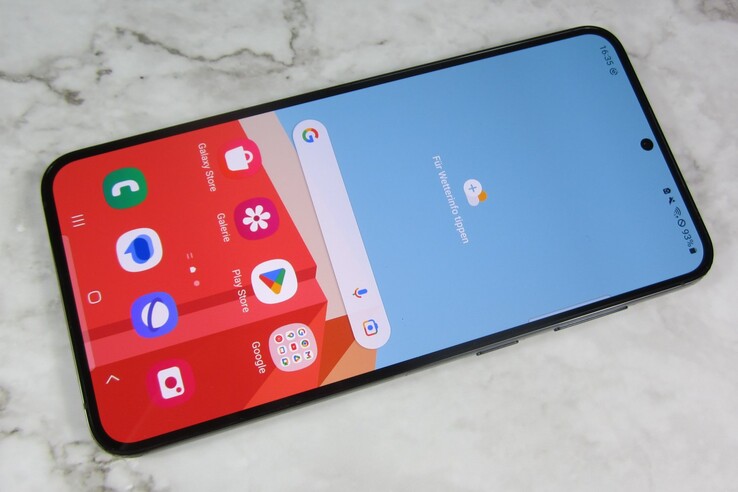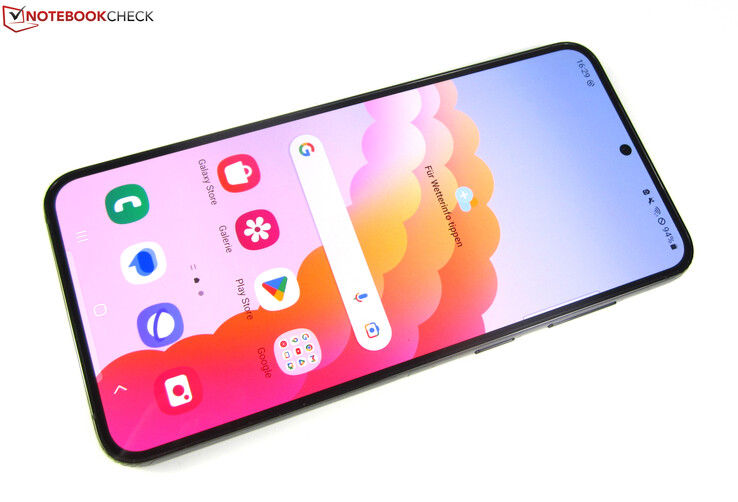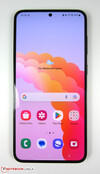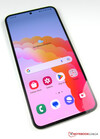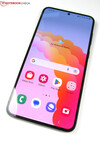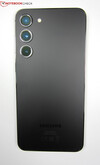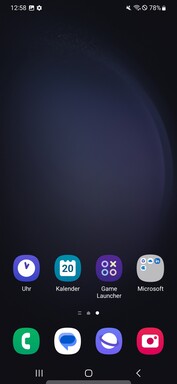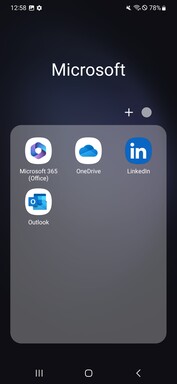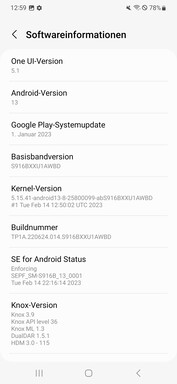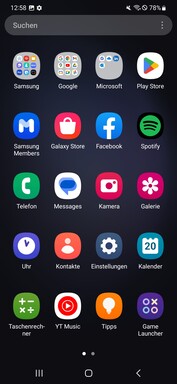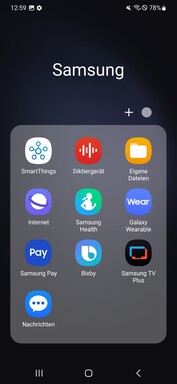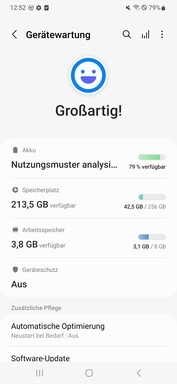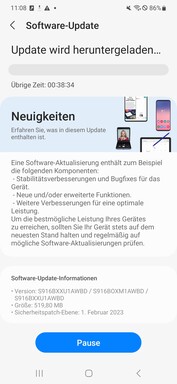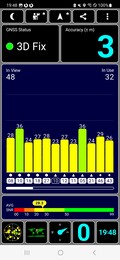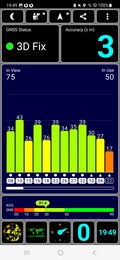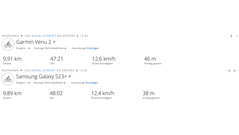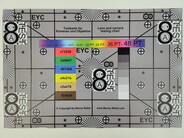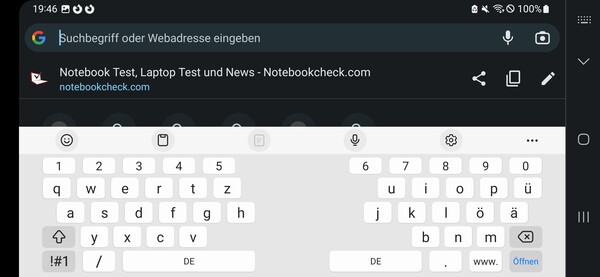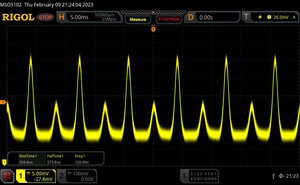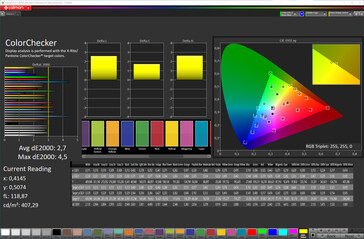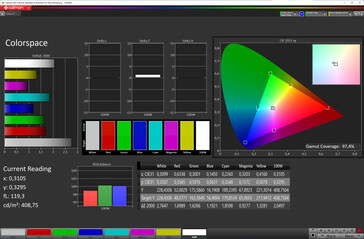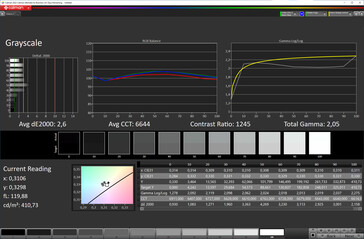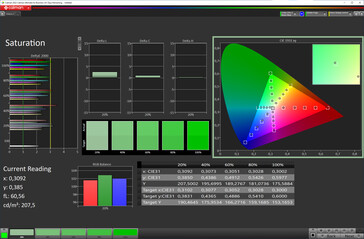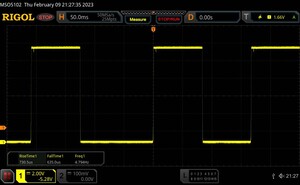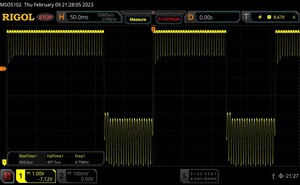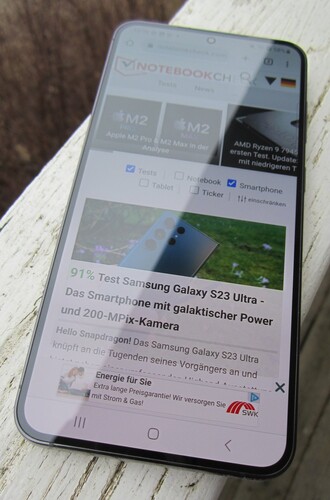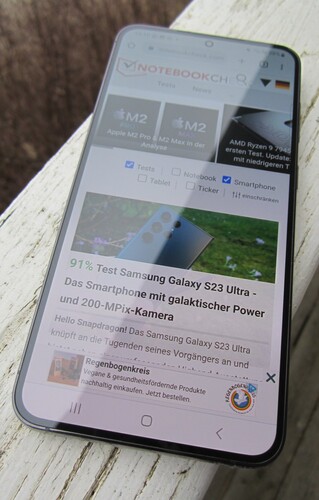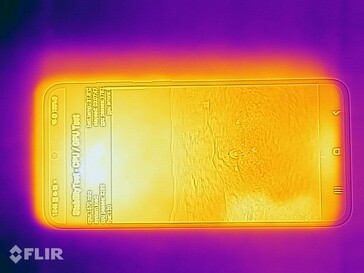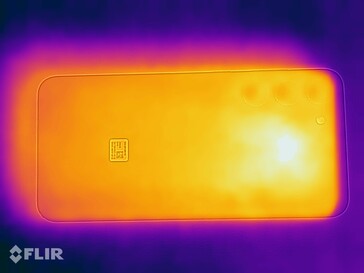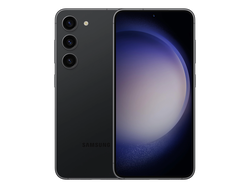Samsung Galaxy S23+ smartphone review – The better Galaxy S23
This year, Samsung is once again expanding its Galaxy S series of flagship smartphones. Right at the top is the 6.8-inch Galaxy S23 Ultra. With an integrated S pen stylus, it manages to bridge the gap between the Galaxy S and the discontinued Galaxy Note series. If it's a size smaller you're after, the 6.1-inch Galaxy S23 is at hand, offering the same Snapdragon 8 Gen 2 for Galaxy found in all representatives of the Galaxy S23 lineup and thereby making it one of the fastest smartphone SoCs currently available.
The 6.6-inch Samsung Galaxy S23+ is the third in the group and sits between the entry-level and top models. However, in terms of features, the review contender is much closer to the Galaxy S23 than the Galaxy S23 Ultra.
For its new Galaxy S smartphones, Samsung is demanding typically ambitious flagship prices. Starting at $799 for the Galaxy S23 with 128 GB of RAM. The Galaxy S23+ officially starts at $1,049 and comes with at least 256 GB of RAM. The same applies to the Galaxy S23 Ultra, with Samsung's asking price starting at $1,199.
Possible competitors compared
Rating | Date | Model | Weight | Drive | Size | Resolution | Price |
|---|---|---|---|---|---|---|---|
| 90.3 % v7 (old) | 03 / 2023 | Samsung Galaxy S23+ SD 8 Gen 2 for Galaxy, Adreno 740 | 195 g | 256 GB UFS 4.0 Flash | 6.60" | 2340x1080 | |
| 90.3 % v7 (old) | 01 / 2023 | Apple iPhone 14 Pro A16, A16 GPU 5-Core | 206 g | 256 GB NVMe | 6.10" | 2556x1179 | |
| 89.1 % v7 (old) | 11 / 2022 | Google Pixel 7 Pro Tensor G2, Mali-G710 MP7 | 212 g | 128 GB UFS 3.1 Flash | 6.70" | 3120x1440 | |
| 88.9 % v7 (old) | 05 / 2022 | Samsung Galaxy S22+ Exynos 2200, Xclipse 920 | 196 g | 128 GB UFS 3.1 Flash | 6.60" | 2340x1080 | |
| 89.1 % v7 (old) | 02 / 2023 | Vivo X90 Pro Dimensity 9200, Immortalis-G715 MP11 | 214.9 g | 256 GB UFS 4.0 Flash | 6.78" | 2800x1260 | |
| 89.2 % v7 (old) | 03 / 2023 | Xiaomi 13 Pro SD 8 Gen 2, Adreno 740 | 229 g | 256 GB UFS 4.0 Flash | 6.73" | 3200x1440 |
Case - a classy chassis made of glass and aluminum
Samsung offers the Galaxy S23+ in the same 6 matte color variations as the Galaxy S23. These comprise four standard colors Lavender, Cream, Phantom Black and Green. In addition, two exclusive colors are available via Samsung's online store, Lime and Graphite.
Just like the Galaxy S22+, the Galaxy S23+ has a frameless, edge-to-edge, flat design with rounded corners and scores points for both its excellent build quality and robustness. IP68 certification remains and certifies that the smartphone can survive undamaged after 30 minutes of submersion in 1.5 meters of fresh water. At an unchanged thickness of 7,6 millimetres, the Galaxy S23+ is only minimally longer and wider than its predecessor and continues to feel well-balanced in the hand.
The biggest design changes from the Galaxy S22 models can be found on the back of the device. The back cover now sits flush with the top left-located triple-camera system. However, as its lenses still protrude around 2 millimetres from the chassis, the Galaxy S23+ wobbles back and forth very slightly on a table, unless it's placed in a protective case.
Similar to its predecessor, the Galaxy S23+ case's frame consists of Armor aluminum. Similar to the front of the device, the back cover has received an upgrade and is now protected by Gorilla Glass Victus 2. This lends the smartphone a very premium feel. A nice side-effect: Thanks to the matte, glass surface, the back cover is relatively fingerprint resistant. Samsung has also raised its sustainability standards. According to the manufacturer, the Galaxy S23+'s case consists of around 22 percent recycled material.
Features - 8 GB of LPDDR5X RAM and at least 256 GB UFS 4.0 storage
Samsung offers the Galaxy S23+ in two memory variants. With 8 GB of LPDDR5X RAM and 256 GB UFS 4.0 mass storage, officially the device costs $1,049, with the manufacturer charging $1,199 for the version with 8/512 GB. The smartphone doesn't come with a microSD slot.
In terms of port selection, the Galaxy S23+ is largely similar to its predecessor. Once again, the USB-C port operates at USB 3.2 Gen.1 speed and, with the help of an adapter, can be used as an audio output. It also supports USB OTG thereby aiding the connection of peripheral devices. Our tests confirm a data transfer speed of 287 MByte/s. On top of that, once again, DRM Widevine L1 is on board.
The Galaxy S23+ also employs typical Samsung features such as DeX desktop mode and the option to use the power button (standard settings) to activate Samsung's own Bixby voice assistant. Anyone wishing to switch the smartphone off can do so via the fast settings.
Apart from memory variants, the battery's capacity and higher performance, the Galaxy S23+ is practically identical to the Galaxy S23. Just like the Galaxy S23 Ultra, the Galaxy S23+ has one additional feature which comes in the form of an ultra-wideband chip (UWB) that can be used, for example, for smart tags and digital keys.
Software - Android 13 and 4 years of OS upgrades
Out-of-the-box, the Galaxy S23+ comes with Android 13 and Samsung's in-house One UI layered over it. This version (5.1), comes with a number of new features. Samsung has compiled a complete list which can be found here.
A strong selling point for the Galaxy S23+ is lengthy software support with Samsung guaranteeing Android OS upgrades for 4 years and security updates for 5 years, starting from the global market launch date (February 2023).
According to the official support website, the Galaxy S23+ receives monthly Android security patches directly from Samsung. Just in time for the mid-February launch, the smartphone promptly received an update which updated the security patch level to February 1, 2023.
In addition to the standard Google apps and some Samsung apps such as SmartThings, Galaxy Wearable, Samsung Pay and Galaxy Store, there is also a small preinstalled selection of Microsoft apps as well as Facebook and Spotify. With the exception of OneDrive, any third-party tools which are surplus to requirements can be uninstalled. OneDrive can only be deactivated.
Communication and GNSS - super speedy WiFi 6E
The Galaxy S23+ supports all current mobile communication standards including 5G Sub6, with only 5G mmWave absent. With 22 4G and 16 5G bands, the smartphone covers a wide range of frequencies and should therefore receive a signal anywhere. Likewise, communication features such as NFC and Bluetooth 5.3 are also part of the package.
The Galaxy S23+ has WiFi 6E and delivers, paired with our reference router, the Asus ROG Rapture GT-AXE11000, very good and stable transfers rates which, in terms of the competition, are only challenged by the Xiaomi 13 Pro. When it comes to 5 GHz WiFi, the Samsung Galaxy smartphone steams ahead of the competition and even manages to leave its predecessor standing.
| Networking | |
| Samsung Galaxy S23+ | |
| iperf3 receive AXE11000 | |
| iperf3 transmit AXE11000 | |
| iperf3 transmit AXE11000 6GHz | |
| iperf3 receive AXE11000 6GHz | |
| Apple iPhone 14 Pro | |
| iperf3 receive AXE11000 | |
| iperf3 transmit AXE11000 | |
| Google Pixel 7 Pro | |
| iperf3 receive AXE11000 | |
| iperf3 transmit AXE11000 | |
| iperf3 transmit AXE11000 6GHz | |
| iperf3 receive AXE11000 6GHz | |
| Samsung Galaxy S22+ | |
| iperf3 receive AXE11000 | |
| iperf3 transmit AXE11000 | |
| iperf3 transmit AXE11000 6GHz | |
| iperf3 receive AXE11000 6GHz | |
| Vivo X90 Pro | |
| iperf3 receive AXE11000 | |
| iperf3 transmit AXE11000 | |
| iperf3 transmit AXE11000 6GHz | |
| iperf3 receive AXE11000 6GHz | |
| Xiaomi 13 Pro | |
| iperf3 receive AXE11000 | |
| iperf3 transmit AXE11000 | |
| iperf3 transmit AXE11000 6GHz | |
| iperf3 receive AXE11000 6GHz | |
| Average of class Smartphone | |
| iperf3 receive AXE11000 | |
| iperf3 transmit AXE11000 | |
| iperf3 transmit AXE11000 6GHz | |
| iperf3 receive AXE11000 6GHz | |
The Galaxy S23+ uses the satellite navigation services GPS (L1, L5), Glonass (L1), Galileo (E1, E5a) and Beidou (B1, B1C, B2a) to determine its location. In testing, the smartphone managed a very fast and accurate (within 3 meters) satellite fix, indoors and outdoors.
On the move, that precision showed itself to be more than sufficient for everyday navigation-based tasks. On a bike tour measuring around 10km, the Galaxy S23+ held its own against the Garmin Venu2 fitness tracker, even though it occasionally deviated slightly from the actual cycled route. However, this also happens with the Garmin Venu2, from time to time.
Telephone functions and call quality
Like its predecessor, the Galaxy S23+ scores well in the area of call quality. Voices are reproduced very naturally and are also easily understood in louder environments. With the speaker activated, slight reverberation crept in. This became more amplified over longer distances but the caller could still be clearly understood.
In addition to VoLTE, the Galaxy S23+ also supports WiFi calls and can accept two 5G- capable SIM cards. Optionally, it is possible to activate an eSIM instead of a physical SIM card.
Cameras - a triple-camera system with 50 MP
The Galaxy S23+ shares the same triple-camera setup as the Galaxy S23 and was also the one found in the Galaxy S22 series. It consists of a 50 MP wide-angle camera with optical image stabilization (OIS), a 12 MP ultra wide-angle camera as well as a 10 MP telephoto camera with OIS and 3x optical zoom.
The 10 MP front-facing camera sits in a punch hole at the top of the display edge and takes good selfies. In addition, it can also record videos at up to 4K at 60 frames per second with video stabilization and HDR10+. Users can also benefit from this with the Galaxy S23+'s 50 MP front-facing camera which can record videos at a maximum of 8K and 30 frames per second. At 4K, a maximum of 60fps is possible. In the Pro video mode, 120fps for Full HD as well as other frame rates for the other resolutions are also available.
With the help of pixel binning, when taking photos, the 50 MP main camera combines 4 adjacent pixels into one, resulting in 12.5 MP images. Using the Photo standard mode, the camera software automatically chooses the best scene settings and this produced good results in our tests.
Overall, sharpness and contrast are good and colors appear natural. Typical for Samsung, they can come across as somewhat overly saturated and vibrant. In particular, this is something that affects red and orange tones. For anyone wishing to tweak all the photo settings such as aperture, exposure and white balance, a switch to Pro mode would help. Using this mode, images can be saved in RAW format instead of the standard JPG image format.
Night shots may often pose insurmountable challenges for many smartphones but they present no problems for the Galaxy S23+'s main camera. In Night mode, it takes detailed photos (even in low light), and reproduces colors relatively realistically.
With its 3x optical zoom (digital up to 30x), the telephoto camera offers more freedom when choosing a subject and takes good quality, shudder-free images, thanks to its optimal image stabilisation. The 12 MP ultra wide-angle camera is the weakest lens of the three. Although colors and contrast are good here too, the edges of the images are both blurry and noisy.
Image comparison
Choose a scene and navigate within the first image. One click changes the position on touchscreens. One click on the zoomed-in image opens the original in a new window. The first image shows the scaled photograph of the test device.
Tageslicht-Aufnahme 1Tageslicht-Aufnahme 2Ultraweitwinkel5-facher ZoomLowlight-AufnahmeUnder controlled lighting conditions, the main camera also delivers good results. With a Delta E of 17, the ColorChecker test chart's colors are reproduced fairly accurately. Even at low light of 1 lux, color accuracy remains comparatively high. Under these difficult lighting conditions, the camera does a good job of capturing and reproducing the test chart well, even if a little blurry.
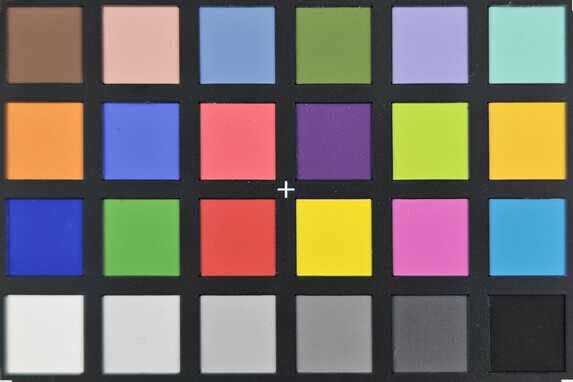

Accessories and warranty - a spartan package
According to Samsung, the Galaxy S23+'s black packaging consists of 100 percent recycled paper. This already gives an indication as to how spartan the accessories might be and is something which is later confirmed upon opening the packaging. The contents are limited to a SIM tool, a USB-C cable, a quick start guide as well as a few booklets and warranty tips.
Anyone on the lookout for maximum charging speed – the Galaxy S23+ supports up to 45 watts – will have to purchase an additional charger. However, on its own online store, Samsung offers a 45-watt charger which costs a whopping 50 euros. If the original accessory is not a must, chargers from third-party suppliers can be had for considerably less.
Samsung provides the Galaxy S23+ with a 24-month warranty. This can be extended with the Care+ insurance which offers contract lengths of either one or two years and also comes with optional protection against theft. These services range from $99 to $249.
Input devices & operation - fast and smooth
Thanks to its powerful hardware under the hood - a Snapdragon 8 Gen 2 for Galaxy, 8 GB of DDR5X RAM and a minimum of 256 GB UFS 3.0 storage, the Galaxy S23+ runs very smoothly, regardless of the situation.
In tests, the smartphone ran as if there was nothing that could really put it under strain. That's how effortlessly it opens apps and switches between already opened applications. The adaptive AMOLED display responds quickly and precisely to all inputs, helping, in large, to contribute to this overall impression.
The Galaxy S23+ also has biometric authentication with the help of an ultrasonic fingerprint sensor and Face Unlock. The former sits under the display and unlocks the Samsung device quickly and reliably. Likewise, the smartphone's 2D face recognition also scores points for a high hit ratio but is not quite as secure.
Display - an AMOLED panel significantly brighter than 1000 nits
The Galaxy S23+'s AMOLED panel displays 2,640 x 1,080 pixels (FHD+) and, in doing so, it has the same resolution as its 6.1-inch sibling model, the Galaxy S23. In standard settings, the OLED screen dynamically adapts its frame rate from 48 to 120 Hz, depending on the application. Alternatively, it can be limited to 60 Hz, in order to save power. In game mode, the AMOLED display runs at a touch sampling rate of up to 240 Hz. HDR10, HDR10+ and HLG are also supported.
Nowadays, brightness in the region of four-digit nits can be expected. The Samsung Galaxy S23+ clears this hurdle with ease and beams at an average of 1136 cd/m² when displaying a solid white background. This is even a smidgen brighter than the Galaxy S22+. In direct comparison, only the Xiaomi 13 Pro can top the Galaxy S23+, coming in at an average brightness of 1244 cd/m².
The Galaxy S23+ comes close to the manufacturer's specification of 1750 cd/m² when we repeat the brightness measurement, this time with a defined amount of dark areas. Subsequently, the luminosity increased noticeably in the APL18 test, topping out at 1630 cd/m². With the brightness sensor deactivated, a maximum of 429 cd/m² and 723 cd/m² are possible when the Additional Brightness option is activated, respectively. At the lowest brightness setting, we measured 1.18 cd/m² which can be reduced to a very good 0.81 cd/m² when Extra Dimming is selected in the Accessibility menu.
At minimum brightness, the Galaxy S23+'s AMOLED panel runs at a constant 120 Hz. At first glance, this seems low, but it is easy on the eyes due to a flat amplitude curve. At brightnesses of greater than 3 percent, the frequency doubles to 240 Hz and manages to remain at a constant level. The Galaxy display's brightness control corresponds to that of an AMOLED panel with permanent DC dimming.
| |||||||||||||||||||||||||
Brightness Distribution: 99 %
Center on Battery: 1128 cd/m²
Contrast: ∞:1 (Black: 0 cd/m²)
ΔE ColorChecker Calman: 2.7 | ∀{0.5-29.43 Ø4.77}
ΔE Greyscale Calman: 2.6 | ∀{0.09-98 Ø5}
97.4% sRGB (Calman 2D)
Gamma: 2.05
CCT: 6644 K
| Samsung Galaxy S23+ Dynamic AMOLED 2x, 2340x1080, 6.6" | Apple iPhone 14 Pro Super Retina XDR OLED, 2556x1179, 6.1" | Google Pixel 7 Pro OLED, 3120x1440, 6.7" | Samsung Galaxy S22+ AMOLED, 2340x1080, 6.6" | Vivo X90 Pro AMOLED, 2800x1260, 6.8" | Xiaomi 13 Pro OLED, 3200x1440, 6.7" | |
|---|---|---|---|---|---|---|
| Screen | 18% | 27% | 5% | 20% | 24% | |
| Brightness middle (cd/m²) | 1128 | 1046 -7% | 1022 -9% | 1090 -3% | 1018 -10% | 1230 9% |
| Brightness (cd/m²) | 1136 | 1049 -8% | 1025 -10% | 1097 -3% | 1026 -10% | 1244 10% |
| Brightness Distribution (%) | 99 | 98 -1% | 99 0% | 98 -1% | 93 -6% | 94 -5% |
| Black Level * (cd/m²) | ||||||
| Colorchecker dE 2000 * | 2.7 | 1.2 56% | 0.9 67% | 2.5 7% | 0.9 67% | 1 63% |
| Colorchecker dE 2000 max. * | 4.5 | 3.1 31% | 2.1 53% | 3.8 16% | 2.2 51% | 2.8 38% |
| Greyscale dE 2000 * | 2.6 | 1.7 35% | 1.1 58% | 2.3 12% | 1.9 27% | 1.8 31% |
| Gamma | 2.05 107% | 2.19 100% | 2.22 99% | 2.04 108% | 2.26 97% | 2.24 98% |
| CCT | 6644 98% | 6538 99% | 6650 98% | 6492 100% | 6473 100% | 6446 101% |
* ... smaller is better
Screen Flickering / PWM (Pulse-Width Modulation)
| Screen flickering / PWM detected | 240 Hz | ||
The display backlight flickers at 240 Hz (worst case, e.g., utilizing PWM) . The frequency of 240 Hz is relatively low, so sensitive users will likely notice flickering and experience eyestrain at the stated brightness setting and below. In comparison: 53 % of all tested devices do not use PWM to dim the display. If PWM was detected, an average of 8081 (minimum: 5 - maximum: 343500) Hz was measured. | |||
Series of measurements with a fixed zoom level and various brightness settings
In terms of color reproduction, the Galaxy S23+ delivers good results but, in the area of color accuracy, it is far down the pack due to a maximum Delta E of 4.5. The display produces its best results in Natural picture mode which uses the sRGB color space. Anyone who prefers more striking but not entirely accurate colors is better served by the preinstalled Vivid picture mode as this also covers the significantly broader DCI P3 color space.
Display Response Times
| ↔ Response Time Black to White | ||
|---|---|---|
| 1.37 ms ... rise ↗ and fall ↘ combined | ↗ 0.7305 ms rise | |
| ↘ 0.635 ms fall | ||
| The screen shows very fast response rates in our tests and should be very well suited for fast-paced gaming. In comparison, all tested devices range from 0.1 (minimum) to 240 (maximum) ms. » 7 % of all devices are better. This means that the measured response time is better than the average of all tested devices (20.2 ms). | ||
| ↔ Response Time 50% Grey to 80% Grey | ||
| 0.98 ms ... rise ↗ and fall ↘ combined | ↗ 0.493 ms rise | |
| ↘ 0.4875 ms fall | ||
| The screen shows very fast response rates in our tests and should be very well suited for fast-paced gaming. In comparison, all tested devices range from 0.165 (minimum) to 636 (maximum) ms. » 3 % of all devices are better. This means that the measured response time is better than the average of all tested devices (31.6 ms). | ||
Performance - Snapdragon instead of Exynos
As with all the phones in the Galaxy S23 series, the Galaxy S23+ is powered by a Snapdragon 8 Gen 2 for Galaxy. Unlike the normal Snapdragon 8 Gen 2, the Galaxy variant runs with a 160 MHz higher clocked Prime Core and manages a maximum of 3.36 GHz instead of the normal 3.2 GHz.
As expected, in the area of single-core performance, the Snapdragon 8 Gen 2 for Galaxy is near the front of the pack but is not the fastest of the high-end SoCs. In this regard, the Galaxy S23+ keeps a clear, respectful distance from the Apple iPhone 14 Pro with its A16 Bionic. The Snapdragon 8 Gen 2 for Galaxy struggles with AImark AI calculations but many other SoCs such as the Google Pixel 7 Pro's Google Tensor 2 don't do any better. However, at the end of the day, these are just numbers as performance is always fluid and the device has an abundance of performance when it comes to everyday use.
| UL Procyon AI Inference for Android - Overall Score NNAPI | |
| Vivo X90 Pro | |
| Google Pixel 7 Pro | |
| Average of class Smartphone (3769 - 81594, n=132, last 2 years) | |
| Samsung Galaxy S23+ | |
| Xiaomi 13 Pro | |
| Average Qualcomm Snapdragon 8 Gen 2 for Galaxy (1267 - 16702, n=8) | |
The Adreno 740 in the Snapdragon 8 Gen 2 for Galaxy is responsible for graphics calculations. This pixel accelerator helps the Galaxy S23+ achieve wonderful GPU performance, but only when sufficient cooling is at hand. In other words: In order to achieve top test scores, we had to let the phone cool down for a while after every session so that throttling could be avoided in the subsequent benchmark test.
GFXBench (DX / GLBenchmark) 2.7: T-Rex Onscreen | 1920x1080 T-Rex Offscreen
GFXBench 3.0: on screen Manhattan Onscreen OGL | 1920x1080 1080p Manhattan Offscreen
GFXBench 3.1: on screen Manhattan ES 3.1 Onscreen | 1920x1080 Manhattan ES 3.1 Offscreen
GFXBench: on screen Car Chase Onscreen | 1920x1080 Car Chase Offscreen | on screen Aztec Ruins High Tier Onscreen | 2560x1440 Aztec Ruins High Tier Offscreen | on screen Aztec Ruins Normal Tier Onscreen | 1920x1080 Aztec Ruins Normal Tier Offscreen
| 3DMark / Wild Life Extreme Unlimited | |
| Vivo X90 Pro | |
| Xiaomi 13 Pro | |
| Samsung Galaxy S23+ | |
| Apple iPhone 14 Pro | |
| Samsung Galaxy S22+ | |
| Google Pixel 7 Pro | |
| 3DMark / Wild Life Extreme | |
| Samsung Galaxy S23+ | |
| Xiaomi 13 Pro | |
| Vivo X90 Pro | |
| Apple iPhone 14 Pro | |
| Samsung Galaxy S22+ | |
| Google Pixel 7 Pro | |
| 3DMark / Wild Life Unlimited Score | |
| Samsung Galaxy S23+ | |
| Xiaomi 13 Pro | |
| Vivo X90 Pro | |
| Apple iPhone 14 Pro | |
| Samsung Galaxy S22+ | |
| Google Pixel 7 Pro | |
| 3DMark / Sling Shot Extreme (ES 3.1) Unlimited Physics | |
| Vivo X90 Pro | |
| Samsung Galaxy S23+ | |
| Google Pixel 7 Pro | |
| Samsung Galaxy S22+ | |
| 3DMark / Sling Shot Extreme (ES 3.1) Unlimited Graphics | |
| Samsung Galaxy S23+ | |
| Vivo X90 Pro | |
| Samsung Galaxy S22+ | |
| Google Pixel 7 Pro | |
| 3DMark / Sling Shot Extreme (ES 3.1) Unlimited | |
| Vivo X90 Pro | |
| Samsung Galaxy S23+ | |
| Samsung Galaxy S22+ | |
| Google Pixel 7 Pro | |
| GFXBench (DX / GLBenchmark) 2.7 / T-Rex Onscreen | |
| Google Pixel 7 Pro | |
| Xiaomi 13 Pro | |
| Samsung Galaxy S23+ | |
| Vivo X90 Pro | |
| Samsung Galaxy S22+ | |
| Apple iPhone 14 Pro | |
| GFXBench (DX / GLBenchmark) 2.7 / T-Rex Offscreen | |
| Xiaomi 13 Pro | |
| Samsung Galaxy S23+ | |
| Apple iPhone 14 Pro | |
| Vivo X90 Pro | |
| Samsung Galaxy S22+ | |
| Google Pixel 7 Pro | |
| GFXBench 3.0 / Manhattan Onscreen OGL | |
| Xiaomi 13 Pro | |
| Samsung Galaxy S23+ | |
| Vivo X90 Pro | |
| Samsung Galaxy S22+ | |
| Google Pixel 7 Pro | |
| Apple iPhone 14 Pro | |
| GFXBench 3.0 / 1080p Manhattan Offscreen | |
| Xiaomi 13 Pro | |
| Apple iPhone 14 Pro | |
| Samsung Galaxy S23+ | |
| Vivo X90 Pro | |
| Samsung Galaxy S22+ | |
| Google Pixel 7 Pro | |
| GFXBench 3.1 / Manhattan ES 3.1 Onscreen | |
| Samsung Galaxy S23+ | |
| Samsung Galaxy S22+ | |
| Xiaomi 13 Pro | |
| Vivo X90 Pro | |
| Apple iPhone 14 Pro | |
| Google Pixel 7 Pro | |
| GFXBench 3.1 / Manhattan ES 3.1 Offscreen | |
| Xiaomi 13 Pro | |
| Samsung Galaxy S23+ | |
| Apple iPhone 14 Pro | |
| Samsung Galaxy S22+ | |
| Vivo X90 Pro | |
| Google Pixel 7 Pro | |
| GFXBench / Car Chase Onscreen | |
| Samsung Galaxy S23+ | |
| Vivo X90 Pro | |
| Samsung Galaxy S22+ | |
| Xiaomi 13 Pro | |
| Apple iPhone 14 Pro | |
| Google Pixel 7 Pro | |
| GFXBench / Car Chase Offscreen | |
| Samsung Galaxy S23+ | |
| Xiaomi 13 Pro | |
| Apple iPhone 14 Pro | |
| Vivo X90 Pro | |
| Samsung Galaxy S22+ | |
| Google Pixel 7 Pro | |
| GFXBench / Aztec Ruins High Tier Onscreen | |
| Samsung Galaxy S23+ | |
| Vivo X90 Pro | |
| Apple iPhone 14 Pro | |
| Samsung Galaxy S22+ | |
| Xiaomi 13 Pro | |
| Google Pixel 7 Pro | |
| GFXBench / Aztec Ruins High Tier Offscreen | |
| Samsung Galaxy S23+ | |
| Xiaomi 13 Pro | |
| Vivo X90 Pro | |
| Apple iPhone 14 Pro | |
| Samsung Galaxy S22+ | |
| Google Pixel 7 Pro | |
| GFXBench / Aztec Ruins Normal Tier Onscreen | |
| Samsung Galaxy S23+ | |
| Vivo X90 Pro | |
| Xiaomi 13 Pro | |
| Samsung Galaxy S22+ | |
| Apple iPhone 14 Pro | |
| Google Pixel 7 Pro | |
| GFXBench / Aztec Ruins Normal Tier Offscreen | |
| Samsung Galaxy S23+ | |
| Xiaomi 13 Pro | |
| Apple iPhone 14 Pro | |
| Vivo X90 Pro | |
| Google Pixel 7 Pro | |
| Samsung Galaxy S22+ | |
In browser benchmarks, the Galaxy S23+ delivered very solid performance helping it belong, along with the Xiaomi 13 Pro, to the fastest Android smartphones in this discipline. However, when it comes to web surfing tests, there's no getting around Apple as the iPhone 14 Pro has impressively shown.
| Jetstream 2 - 2.0 Total Score | |
| Apple iPhone 14 Pro (Safari 16) | |
| Samsung Galaxy S23+ (Chrome 110.0.5481.65) | |
| Average Qualcomm Snapdragon 8 Gen 2 for Galaxy (152.9 - 196.3, n=8) | |
| Average of class Smartphone (23.8 - 387, n=147, last 2 years) | |
| Xiaomi 13 Pro (Chrome 109) | |
| Samsung Galaxy S22+ (Chrome 100.0.4896.127) | |
| Google Pixel 7 Pro (Chrome 106) | |
| Vivo X90 Pro (Chrome 109) | |
| Speedometer 2.0 - Result 2.0 | |
| Apple iPhone 14 Pro (Safari 16) | |
| Average of class Smartphone (15.2 - 643, n=119, last 2 years) | |
| Average Qualcomm Snapdragon 8 Gen 2 for Galaxy (136 - 197, n=6) | |
| Samsung Galaxy S23+ (Chrome 110.0.5481.65) | |
| Xiaomi 13 Pro (Chrome 109) | |
| Samsung Galaxy S22+ (Chrome 100.0.4896.127) | |
| Google Pixel 7 Pro (Chrome 106) | |
| Vivo X90 Pro (Chrome 109) | |
| WebXPRT 4 - Overall | |
| Apple iPhone 14 Pro (Safari 16) | |
| Average Qualcomm Snapdragon 8 Gen 2 for Galaxy (145 - 187, n=8) | |
| Xiaomi 13 Pro (Chrome 109) | |
| Samsung Galaxy S23+ (Chrome 110.0.5481.65) | |
| Average of class Smartphone (27 - 306, n=143, last 2 years) | |
| Google Pixel 7 Pro (Chrome 106) | |
| Vivo X90 Pro (Chrome 109) | |
| Octane V2 - Total Score | |
| Apple iPhone 14 Pro (Safari 16) | |
| Samsung Galaxy S23+ (Chrome 110.0.5481.65) | |
| Average Qualcomm Snapdragon 8 Gen 2 for Galaxy (49582 - 64715, n=8) | |
| Average of class Smartphone (2228 - 126661, n=194, last 2 years) | |
| Samsung Galaxy S22+ (Chrome 100.0.4896.127) | |
| Google Pixel 7 Pro (Chrome 106) | |
| Xiaomi 13 Pro (Chrome 109) | |
| Vivo X90 Pro (Chrome 109) | |
| Mozilla Kraken 1.1 - Total | |
| Vivo X90 Pro (Chrome 109) | |
| Samsung Galaxy S22+ (Chrome 100.0.4896.127) | |
| Average of class Smartphone (257 - 28190, n=154, last 2 years) | |
| Google Pixel 7 Pro (Chrome 106) | |
| Average Qualcomm Snapdragon 8 Gen 2 for Galaxy (634 - 1533, n=8) | |
| Samsung Galaxy S23+ (Chrome 110.0.5481.65) | |
| Xiaomi 13 Pro (Chrome 109) | |
| Apple iPhone 14 Pro (Safari 16) | |
* ... smaller is better
Fast UFS 4.0 storage ensures the Galaxy S23+ has exceptionally short loading times. However, in the area of write performance, the device struggles to keep up with smartphones such as the Vivo X90 Pro or the Xiaomi 13 Pro - a device which also boasts UFS 4.0 storage. Among the competing smartphones, the Galaxy S23+ brings up the rear when it comes to 4KB random writes.
| Samsung Galaxy S23+ | Google Pixel 7 Pro | Samsung Galaxy S22+ | Vivo X90 Pro | Xiaomi 13 Pro | Average 256 GB UFS 4.0 Flash | Average of class Smartphone | |
|---|---|---|---|---|---|---|---|
| AndroBench 3-5 | -16% | 2% | 99% | 101% | 81% | 35% | |
| Sequential Read 256KB (MB/s) | 3250.14 | 1346.78 -59% | 1629.99 -50% | 3866.75 19% | 3587.83 10% | 3664 ? 13% | 2235 ? -31% |
| Sequential Write 256KB (MB/s) | 1014.33 | 874.73 -14% | 1001.67 -1% | 2643.38 161% | 2601.45 156% | 2701 ? 166% | 1871 ? 84% |
| Random Read 4KB (MB/s) | 441.77 | 219.01 -50% | 306.7 -31% | 367.89 -17% | 387.72 -12% | 381 ? -14% | 297 ? -33% |
| Random Write 4KB (MB/s) | 156.82 | 253.18 61% | 297.67 90% | 521.43 233% | 546.98 249% | 405 ? 158% | 343 ? 119% |
Gaming - not always as smooth as expected
In terms of gaming, the Galaxy S23+ has power in abundance with Armajet fully showcasing the AMOLED display's maximum possible 120 Hz. However, in other games, this is not always guaranteed. For example, in PUBG mobile, the smartphone can only achieve a maximum of 60 frames per second at HD/ extreme settings and only 40fps at HD/ultra. Both test games suffer frequent drops in frame rate. Although not noticeable in-game, they do show that there is still room for driver optimization.
We used our testing tool, Gamebench, to determine game frame rates.
Emissions - cool in operation but with significant throttling
Temperature
While in operation, the Galaxy S23+ stays cool. Even after an hour of stress testing, we were only able to coax a maximum surface temperature of 32,7 °C from the device. However, in order to achieve this, internal components have to be severely throttled.
The 3DMark stress test showed how quickly this happens: In some cases, the performance had already dropped after the first 20 benchmark runs. In the end, less than 60 percent of the original frame rate remained. However, in everyday use, this performance loss shouldn't be noticeable as, even in the worst case, plenty of power is still at hand.
(+) The maximum temperature on the upper side is 32.7 °C / 91 F, compared to the average of 35.2 °C / 95 F, ranging from 21.9 to 247 °C for the class Smartphone.
(+) The bottom heats up to a maximum of 30.8 °C / 87 F, compared to the average of 34 °C / 93 F
(+) In idle usage, the average temperature for the upper side is 23.2 °C / 74 F, compared to the device average of 32.9 °C / 91 F.
3DMark Wild Life Stress Test
| 3DMark | |
| Wild Life Stress Test Stability | |
| Xiaomi 13 Pro | |
| Apple iPhone 14 Pro | |
| Vivo X90 Pro | |
| Google Pixel 7 Pro | |
| Samsung Galaxy S22+ | |
| Samsung Galaxy S23+ | |
| Wild Life Extreme Stress Test | |
| Xiaomi 13 Pro | |
| Vivo X90 Pro | |
| Google Pixel 7 Pro | |
| Apple iPhone 14 Pro | |
| Samsung Galaxy S22+ | |
| Samsung Galaxy S23+ | |
Speakers
The Galaxy S23+'s Dolby Atmos-certified stereo speakers produce good sound which remains distortion-free, even at maximum volume. Bass tones get lost somewhat in the sound mix but are still considerably more present than many smartphones.
Wired headphones or a speaker can be connected to the smartphone via a USB-C cable (not included). Wirelessly, this is done via Bluetooth 5.3. However, with AAC, SBC, aptX, LDAC and Samsung's Seamless codec (SSC), the selection of Bluetooth codecs is not particularly extensive.
Samsung Galaxy S23+ audio analysis
(+) | speakers can play relatively loud (91.8 dB)
Bass 100 - 315 Hz
(-) | nearly no bass - on average 21.7% lower than median
(+) | bass is linear (5.8% delta to prev. frequency)
Mids 400 - 2000 Hz
(±) | reduced mids - on average 5.8% lower than median
(+) | mids are linear (4.3% delta to prev. frequency)
Highs 2 - 16 kHz
(+) | balanced highs - only 4.4% away from median
(+) | highs are linear (2.6% delta to prev. frequency)
Overall 100 - 16.000 Hz
(±) | linearity of overall sound is average (16.2% difference to median)
Compared to same class
» 6% of all tested devices in this class were better, 5% similar, 90% worse
» The best had a delta of 11%, average was 35%, worst was 134%
Compared to all devices tested
» 25% of all tested devices were better, 5% similar, 69% worse
» The best had a delta of 4%, average was 24%, worst was 134%
Samsung Galaxy S22+ audio analysis
(+) | speakers can play relatively loud (91.3 dB)
Bass 100 - 315 Hz
(-) | nearly no bass - on average 23.2% lower than median
(±) | linearity of bass is average (7.1% delta to prev. frequency)
Mids 400 - 2000 Hz
(±) | higher mids - on average 5.5% higher than median
(+) | mids are linear (4.5% delta to prev. frequency)
Highs 2 - 16 kHz
(±) | higher highs - on average 5.8% higher than median
(+) | highs are linear (6.1% delta to prev. frequency)
Overall 100 - 16.000 Hz
(±) | linearity of overall sound is average (18% difference to median)
Compared to same class
» 16% of all tested devices in this class were better, 8% similar, 76% worse
» The best had a delta of 11%, average was 35%, worst was 134%
Compared to all devices tested
» 37% of all tested devices were better, 8% similar, 55% worse
» The best had a delta of 4%, average was 24%, worst was 134%
Battery life - almost limitless staying power
Power consumption
The benefits of Galaxy S23+'s SoC switch to Snapdragon 8 Gen 2 are not only seen in terms of higher performance. On the plus side, compared to the Galaxy S22+ and its Samsung Exynos 2200, the device uses significantly less power.
Looking beyond the world of Samsung, it becomes even more apparent how well the Galaxy S23+ budgets its battery capacity with it running quite a bit more economically than all other competing devices. The Apple iPhone 14 Pro comes closest to our review contender.
| Off / Standby | |
| Idle | |
| Load |
|
Key:
min: | |
| Samsung Galaxy S23+ 4700 mAh | Apple iPhone 14 Pro 3200 mAh | Google Pixel 7 Pro 5000 mAh | Samsung Galaxy S22+ 4500 mAh | Vivo X90 Pro 4870 mAh | Xiaomi 13 Pro 4820 mAh | Average Qualcomm Snapdragon 8 Gen 2 for Galaxy | Average of class Smartphone | |
|---|---|---|---|---|---|---|---|---|
| Power Consumption | -12% | -30% | -39% | -69% | -36% | -103% | -61% | |
| Idle Minimum * (Watt) | 0.64 | 0.56 12% | 0.78 -22% | 0.71 -11% | 0.9 -41% | 1.02 -59% | 1.531 ? -139% | 0.847 ? -32% |
| Idle Average * (Watt) | 0.88 | 1.37 -56% | 1.61 -83% | 1.1 -25% | 2.32 -164% | 1.36 -55% | 1.848 ? -110% | 1.446 ? -64% |
| Idle Maximum * (Watt) | 0.94 | 1.42 -51% | 1.63 -73% | 1.19 -27% | 2.39 -154% | 1.58 -68% | 1.998 ? -113% | 1.63 ? -73% |
| Load Average * (Watt) | 4.18 | 3.42 18% | 3.29 21% | 7.74 -85% | 3.64 13% | 4.29 -3% | 7.9 ? -89% | 6.95 ? -66% |
| Load Maximum * (Watt) | 6.59 | 5.56 16% | 6.01 9% | 9.64 -46% | 6.53 1% | 6.15 7% | 10.7 ? -62% | 11.3 ? -71% |
* ... smaller is better
Power consumption: Geekbench (150 cd/m²)
Power consumption: GFXBench (150 cd/m²)
Battery life
In terms of battery life, the Galaxy S23+ is convincing right across the board and lasts much longer than the Galaxy S22+. The smartphone leaves the competition standing with almost 20 hours of simulated internet surfing and over 25 hours of video playback - both at 150 cd/m² using adaptive display brightness. All in all, only the Apple iPhone 14 Pro can achieve similarly good battery life, followed by the Galaxy S22+ in a distant third place.
The Galaxy S23+'s 4700 mAh battery can be charged at a maximum of 45 watts. The job of finding a suitable charger is, however, left to the user as none is included in the box. Wirelessly, the Galaxy S23+ can be replenished at up to 15 watts. Thanks to wireless PowerShare, the smartphone can be used to charge other devices wirelessly (Qi wireless charging standard).
| Samsung Galaxy S23+ 4700 mAh | Apple iPhone 14 Pro 3200 mAh | Google Pixel 7 Pro 5000 mAh | Samsung Galaxy S22+ 4500 mAh | Vivo X90 Pro 4870 mAh | Xiaomi 13 Pro 4820 mAh | |
|---|---|---|---|---|---|---|
| Battery runtime | -11% | -39% | -18% | -24% | -31% | |
| Reader / Idle (h) | 43.1 | 44.3 3% | 20.2 -53% | 42.9 0% | 25.2 -42% | |
| H.264 (h) | 25.4 | 23.3 -8% | 20.2 -20% | 17 -33% | 21.1 -17% | |
| WiFi v1.3 (h) | 19.9 | 13.5 -32% | 11.3 -43% | 13.1 -34% | 15.2 -24% | 14.1 -29% |
| Load (h) | 6.4 | 5.9 -8% | 3.8 -41% | 6.1 -5% | 4.2 -34% |
Pros
Cons
Verdict - Samsung Galaxy S23+
Like its sibling models in the S23 series, the Samsung Galaxy S23+ is one of the best Android smartphones currently available. Compared to its predecessor, the changes are relatively modest. However, the few areas in which Samsung has optimized its smartphone add real value.
By switching from Exynos SoC to the Snapdragon 8 Gen 2 for Galaxy, the Galaxy S23+ doesn't only benefit from improved performance but the device also handles the power provided by its 4700 mAh battery in a significantly more economical manner. As a result, compared to the Galaxy S22+, battery life is tangibly better, making the Galaxy S23+ a real long-distance runner.
The Samsung Galaxy S23+ is currently one of the best Android smartphones and comes with considerably better battery life than its predecessor.
What does remain are the qualities for which the Galaxy S22+ was also famous: An adaptive 120 Hz display, a good triple-camera system, 5G with Dual SIM and eSIM, an ultra-wideband chip (UWB), WiFi 6E and the promise of long updates.
Incidentally, the starting price for the Galaxy S23+ is not much higher than that of the Galaxy S22+. Back then, Samsung charged $1049 for the 8/256 GB storage model, or, in other words around $50 less than the Galaxy S23+. In addition to the Galaxy S22+, which can now be had for under $700, the Google Pixel 7 Pro provides a cheaper but equally powerful alternative.
Price and availability
If the Galaxy S23+ is bought directly from Samsung, the 8/256 GB model currently costs $999 and the 8/512 GB version can be had for $1,119. At the time of review, both memory variants can be had for somewhat less in various online stores.
Samsung Galaxy S23+
- 03/07/2023 v7 (old)
Manuel Masiero
Transparency
The selection of devices to be reviewed is made by our editorial team. The test sample was provided to the author as a loan by the manufacturer or retailer for the purpose of this review. The lender had no influence on this review, nor did the manufacturer receive a copy of this review before publication. There was no obligation to publish this review. As an independent media company, Notebookcheck is not subjected to the authority of manufacturers, retailers or publishers.
This is how Notebookcheck is testing
Every year, Notebookcheck independently reviews hundreds of laptops and smartphones using standardized procedures to ensure that all results are comparable. We have continuously developed our test methods for around 20 years and set industry standards in the process. In our test labs, high-quality measuring equipment is utilized by experienced technicians and editors. These tests involve a multi-stage validation process. Our complex rating system is based on hundreds of well-founded measurements and benchmarks, which maintains objectivity. Further information on our test methods can be found here.


